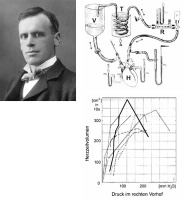Introduction
The evolution of isolated heart perfusion models represents a monumental journey spanning over a century. This methodological advancement stands unparalleled, not only in its prolonged developmental timeline but also in its profound impact on cardiac science. Isolated heart perfusion has been instrumental in unraveling intricate details of myocardial function, the regulation of coronary blood flow, and cardiac metabolism [1]. The experimental method commonly known as Langendorff’s heart model owes its development to the contributions of numerous scientists who preceded and followed Oscar Langendorff. The model’s development involved a diverse group of eminent scientists, each bringing unique perspectives and fervor to the research. Their collective efforts have provided invaluable insights and a robust framework for understanding the heart’s physiology, laying the groundwork for both theoretical and applied advancements in medical and biological sciences [2, 3]. This paper aims to explore the historical progression, key contributors, and significant scientific achievements associated with isolated heart perfusion experiments, highlighting their enduring influence on the field of cardiac physiology.
Historical background
The foundations set by Carl Ludwig
The inception of isolated organ perfusion techniques can be attributed to the pioneering efforts of Carl Ludwig, who is often considered as the actual founder of modern physiology [4]. Born on December 29, 1816, in Witzenhausen, Germany, Ludwig embarked on his medical studies in 1834 at the University of Marburg, completing them in 1840 [5]. He initially worked in Robert Bunsen’s laboratory before transitioning to an academic career. In 1846, he joined the Anatomy Department at the University of Marburg, and three years later, he was appointed at the University of Zurich, Switzerland. His academic journey continued at the Collegium Medico-Chirurgicum Josephinum in Vienna, where he served as professor of Physiology and Zoology from 1855. Ludwig’s career culminated when he assumed the role of the Chair of the Department of Physiology at the University of Leipzig on May 1, 1865, where he inaugurated a new Physiology Institute on April 26, 1869 (Figure 1). The institute was a testament to his comprehensive methodological approach. He dedicated over 25 years to the institute before passing away on April 23, 1895 [5].
Figure 1
Carl Ludwig at the Physiology Institute he founded in Leipzig, showcasing the historical context and significance of the institution in physiological studies

Carl Ludwig was a central figure in a paradigm shift within physiological research, moving away from natural philosophy and vitalism. He, along with a cadre of young, dynamic physiologists, including Emil du Bois-Reymond (1818–1896), Ernst Brücke (1819–1892), and Hermann Helmholtz (1821–1894), advocated for the “organic physicists” movement, which posited that physiological processes were governed solely by physical and chemical forces [5, 6]. Ludwig authored a seminal physiology textbook in 1852, outlining the principles of this new scientific direction. His commitment to empirical research led to the early development of the isolated heart perfusion model. In 1846, one of Ludwig’s students, Wild, reported preliminary experiments conducted in Ludwig’s laboratory in Marburg. That same year, Ludwig invented the oscillograph, a groundbreaking device for recording physiological activities over time. Other significant achievements in his ongoing research included intraarterial monitoring, arterial tonometry, the volume clamp method, and cuffless blood pressure technologies [7]. Together with Wild, Ludwig pioneered a technique in which they connected the aorta of a deceased animal to the carotid artery of a living donor [8, 9]. This setup maintained the coronary artery perfusion in the recipient heart, creating a viable, beating heart preparation that retained contractility for extended periods, provided blood clotting was inhibited. This model enabled stimulation and removal of heart sections without compromising overall heart functionality [9]. This foundational work by Carl Ludwig not only advanced the understanding of cardiac function but also set the stage for future innovations in isolated heart perfusion [6].
Elias Cyon and the isolated frog heart model
The quest to maintain a completely isolated heart in a viable state for extended periods led to significant advancements by Elias Cyon, particularly using the frog as the model organism [10]. The frog heart was deemed ideal due to its spongy structure and absence of coronary arteries, allowing gas and metabolite exchange entirely through diffusion. Working at Carl Ludwig’s Leipzig Physiological Institute, Cyon pioneered the technique for isolating the frog heart and studied the effects of temperature changes on its function. His seminal work marked a crucial development in cardiac physiology [3, 10].
Born Ilya Fadeyevich Tsion in 1842 in a small Jewish community in Lithuania, Cyon pursued his medical education at the Warsaw Academy, followed by the University of Kyiv in Ukraine, and later completed his doctorate at the University of Berlin in Germany [11]. His academic journey took him to the St. Petersburg Medical and Surgical Academy, where he obtained another doctorate in 1865. Sponsored by the Russian Ministry of Education, he studied physiology in Paris, likely under Claude Bernard, before joining Ludwig in Leipzig. After his stint in Leipzig, Cyon returned to St. Petersburg, becoming director of the University’s Physiology Laboratory in 1868, and shortly thereafter a professor of anatomy [12]. Among his students was Ivan Petrovitch Pavlov, a future Nobel laureate. Cyon’s career in Russia ended amidst controversy in 1874, leading him to relocate to Paris, where he adopted the name Élie de Cyon and engaged in various political and diplomatic activities until his death in 1910 [3].
During his brief tenure at the Leipzig Institute, Cyon’s innovations included a novel experimental setup for studying the isolated frog heart (Figure 2). He cannulated the aorta and vena cava of the heart and used rabbit serum as the perfusion fluid. This setup included a circulatory system encased in glass, where serum temperature could be controlled and heart function metrics like pressure and rate monitored via connections to a mercury manometer. His findings were crucial; he observed that heart rate increased with temperature within a fever range but declined beyond a certain threshold. Additionally, he noted changes in heart elasticity with temperature variations and proposed an early theory of what would later be recognized as “excitation-contraction coupling” in cardiac physiology [3, 10].
Figure 2
Elias Cyon alongside the isolated heart device he pioneered, illustrating the mechanism and setup used in his groundbreaking experiments

This experimental setup revealed that adequate serum volume is necessary for inducing diastolic filling pressure, enabling ventricular fluid ejection. Heart rate increased with temperature up to a peak, then declined sharply beyond this point. Within a fever-range temperature, heart rate increased, while pressure rose slightly above 0°C, peaking between 15 and 19°C before dropping after 20°C. This indicated a dissociation between heart rate and contraction amplitude across temperatures. Additionally, changes in heart elasticity were noted with temperature fluctuations, attributed to two components of the heart’s excitatory system: one generating impulses and another regulating their rhythmic transition to motor nerves. This early investigation into cardiac excitation-contraction coupling predates the known involvement of sodium and calcium ions in these processes [13].
Cyon’s contributions, although initially focused on basic physiological responses to environmental changes, laid foundational insights into cardiac dynamics that have influenced decades of subsequent research in heart physiology [11].
Henry Pickering Bowditch and the advancement of cardiac physiology
The isolated frog heart model underwent further refinements under the auspices of Carl Ludwig’s Leipzig Physiological Institute, where the American soldier, physician, physiologist Henry Pickering Bowditch (1840–1911) made substantial contributions [14]. Born in Boston, Massachusetts, he was a descendant of the noted mathematician Nathaniel Bowditch. After graduating from Harvard College in 1861, he briefly studied at Harvard’s Lawrence Scientific School but his studies were interrupted by his service as a major in the Union Army during the American Civil War. He later graduated from Harvard Medical School in 1868 and pursued further studies in Europe with prominent scientists including Claude Bernard in Paris and Carl Ludwig in Leipzig, where he made significant contributions to physiological research. During his tenure at the Leipzig Institute, Bowditch’s personal life flourished alongside his professional achievements; he married the daughter of a Leipzig banker and subsequently relocated to Boston. Bowditch started his career at Harvard in 1871 as an assistant professor of physiology and later became the dean of the medical school. There, he established the first university physiology laboratory in the United States at Harvard Medical School and became a founding member and the first President of the American Physiological Society (Figure 3) [15–17]. He was honored with several honorary degrees and, in recognition of his contributions, the American Physiological Society named the “Henry Pickering Bowditch Award Lecture” after him. Bowditch retired in 1906 and passed away in 1913 [16–18].
Figure 3
Henry Pickering Bowditch at the Lawrence School of Science, Harvard University, highlighting his contributions to the field of physiology and his educational influence
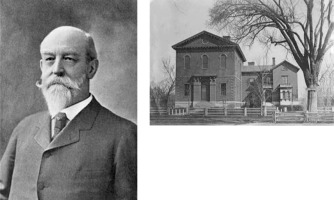
In an effort to explore the effects of vagal stimulation, Bowditch developed a new preparation that exposed the vagus nerve from the spinal cord to the heart. Unlike Elias Cyon’s setup, Bowditch opted for a non-recirculating system, where the aorta was connected to a mercury manometer and a separate cannula was inserted into the sinus, connected to a reservoir filled with rabbit serum [15].
In a notable modification, Bowditch inserted a glass cannula into the atrium of a dissected frog heart, extending it into the upper third of the ventricle and securing it in place. An additional cannula was inserted into the ventricle and connected to a mercury manometer. The heart’s apex was electrically stimulated, allowing for the observation of frequency and amplitude of contractions via an oscilloscope. This led to the discovery of the “Treppe” effect. The Treppe phenomenon, also known as the staircase phenomenon or frequency-dependent activation, suggests that an elevation in heart rate enhances the contractile force of myocardial cells with each successive heartbeat, independent of other factors [10, 16, 17].
Bowditch’s work elucidated several fundamental cardiac phenomena: the all-or-none law, the absolute refractory period, and the origins of cardiac automaticity, primarily located in the atrium and atrioventricular region [18]. These discoveries were underpinned by changes in calcium concentration within the sarcoplasmic reticulum of cardiac muscle cells and its release into the sarcoplasm [3].
His contributions to cardiovascular research continued, notably with significant findings using the isolated rat heart model. Bowditch’s innovations not only propelled forward the understanding of cardiac mechanics but also set the stage for future explorations into heart physiology [3, 18].
Advancements through subsequent investigators
Following the pioneering work of early physiologists, numerous researchers advanced the study of cardiac physiology through innovative experiments using the isolated heart model. In 1896, Coats made a significant observation that stimulation of the vagus nerve diminished the heart’s contractile response to electrical stimulation on its surface. This finding paved the way for further exploration by Webers, who demonstrated that electrical stimulation of brain regions where the vagus nerve originates, as well as the vagus nerve itself, could induce cardiac arrest. Additionally, Schmiedeberg contributed to the understanding of vagal stimulation by showing that its negative chronotropic effect – reducing heart rate – could be blocked by agents like nicotine or atropine [3]. Sidney Ringer expanded the application of the isolated frog heart model by elucidating the crucial role of calcium ions (Ca2+) in cardiac contraction [19]. This insight into the biochemical underpinnings of heart mechanics was a major step forward in the field.
These researchers collectively pushed the boundaries of cardiovascular physiology, each building on the work of their predecessors and contributing unique insights that would shape the scientific understanding of heart function for generations to come. Their work exemplifies the iterative nature of scientific inquiry and the importance of experimental models in biomedical research.
Henry Newell Martin and the evolution of the mammalian heart-lung preparation
The exploration of the mammalian heart’s complexities began as early as 1846, pioneered by researchers such as Wild and Ludwig. Due to the inherent challenges of studying such complex systems, initial research predominantly utilized the simpler isolated frog heart, which lacks coronary circulation and contains only one ventricle. This model was well-established at Ludwig’s Institute by 1870, attracting numerous scholars, including Michael Foster from University College London. Foster, after mastering the technique, introduced it to Henry Newell Martin upon returning to London. Born in 1848 in Ireland, Martin later collaborated with Thomas Huxley, a prominent British biologist, and honed his skills at the Leipzig Physiological Institute in the summer of 1875 [3].
Following a recommendation from Huxley, Martin was appointed the Chair of Biology at Johns Hopkins University, where he initiated his seminal work on the isolated mammalian heart in 1880. Shortly thereafter, his health and vigor began to wane. Following 1891, and more acutely after his wife’s passing in 1892, his physical state worsened, exacerbated by unchecked alcoholism and further complicated by sporadic, potentially iatrogenic addiction to morphine. Although there were brief periods of improvement due to attentive care, he experienced several setbacks. Ultimately, Martin’s declining health led him to resign in 1893. He returned to England and passed away in Yorkshire on October 27, 1896. Despite personal adversities and health issues, Martin’s research marked a significant advancement in physiological studies by transitioning from amphibian to mammalian models [20, 21].
Martin’s groundbreaking innovation was the development of the mammalian heart-lung preparation. In this setup, he used cats or dogs, maintaining artificial ventilation while isolating the systemic circulation except for the coronary circuit. This was achieved by inserting a cannula into the left subclavian artery linked to a manometer to exclusively study coronary circulation. The blood, after being pumped by the left ventricle through the coronary arteries, would return via the right atrium, pass through the right ventricle, and get oxygenated in the pulmonary artery before returning to the left heart [3, 22].
Martin further refined this model by using calf’s blood from Mariotte flasks to sustain circulation within an artificially ventilated dog positioned in a warm, humid chamber. This setup allowed for the independent adjustment of preload and afterload, with blood circulating through the system for accurate adjustments and measurements of aortic pressure using a sliding transfer tube (Figure 4). Additionally, cannulas were inserted into both carotid arteries, connected to manometers to measure pressure and pulse, which were recorded on a large oscilloscope [22].
Figure 4
Henry Newell Martin with the isolated mammalian heart irrigation device he developed, detailing the device’s design and its impact on cardiac research
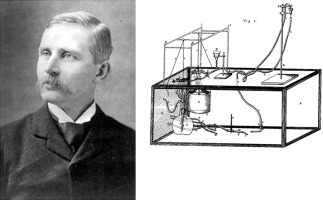
This sophisticated heart-lung preparation pioneered by Martin not only propelled forward the study of mammalian cardiovascular systems but also laid the groundwork for understanding the intricate dynamics of heart and lung interactions under controlled experimental conditions. His contributions were pivotal, illustrating a significant shift toward more advanced experimental setups in cardiovascular physiology research [20–22].
Oscar Langendorff and the innovation of the isolated mammalian heart
Oscar Langendorff significantly advanced the study of the isolated mammalian heart, pioneering a method that allowed for the perfusion and sustenance of mammalian hearts for extended periods [23]. Born on February 1, 1853, in Breslau (now Wrocław, Poland), he pursued his medical studies at the universities of Breslau, Berlin, and Freiburg im Breisgau, earning his doctorate in 1875 from the Albertus University of Königsberg. Following his graduation, he served as a research assistant and, in 1879, completed his habilitation under the mentorship of physiologist Ludimar Hermann. By 1884, he had risen to the rank of associate professor. In 1886, Langendorff was inducted as a member of the German National Academy of Sciences Leopoldina. In 1892, Langendorff joined the University of Rostock, where he served as a full professor and the director of the physiological institute until his death in 1908 [24].
Langendorff’s research spanned several areas within physiology, including cardiac, respiratory, digestive, and nervous systems [23]. His seminal discovery, published in Pflüger’s Archive in 1895, demonstrated that a non-beating heart could only be resuscitated if it had been adequately oxygenated beforehand. His method, often referred to as the “Langendorff heart,” remains a fundamental technique in laboratories over a century later, demonstrating the enduring impact of his contributions [25].
The Langendorff technique involved isolating a mammalian heart and maintaining its function through direct perfusion. This was achieved by inserting an irrigation cannula into the aorta, connecting it to a blood reservoir. The setup included a sophisticated mechanism to regulate perfusion pressure and temperature, ensuring the heart’s functionality could be sustained for hours. This setup allowed Langendorff to explore cardiac functions and responses to various stimuli in a controlled environment (Figure 5) [3, 25].
Figure 5
Oscar Langendorff depicted with the isolated mammalian heart irrigation device he refined, emphasizing the enhancements he introduced to the study of heart physiology
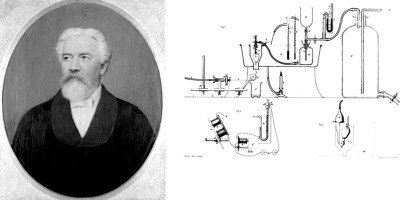
One of Langendorff’s groundbreaking observations was that a mammalian heart could regain and maintain its automacy after excision and perfusion, challenging prevailing beliefs about heart excitability and the role of blood in the ventricular cavities. His experiments demonstrated the critical role of coronary artery perfusion and explored the effects of various substances and conditions on heart behavior, such as the responses to muscarine, atropine, and changes in temperature [8, 26].
Moreover, Langendorff alongside Bornstein in 1906 observed that a premature systole during the absolute unexcitable period of the heart may be followed by a pulse whose force of contraction is greater than that of all the preceding contractions. This phenomenon, although not typical for all species, occurs in humans, rats, and mice. This insight paved the way for further research into systolic cardiac function, illustrating the broader implications of his work on our understanding of cardiac physiology [26].
Through these contributions, Langendorff not only differentiated his work from his predecessors but also established a foundation that would inform countless studies and innovations in cardiovascular physiology for generations to come [23]. Since 2016, his contributions to physiology have been commemorated with the “Langendorff Prize for the best performance in the year in physiology,” awarded annually in his honor.
Otto Loewi’s pioneering research: unveiling chemical neurotransmission and transforming heart physiology
Otto Loewi’s pioneering experiments in the early 20th century significantly advanced the field of heart physiology through his innovative use of the isolated heart experimental model. Conducting his seminal research in the 1920s, Loewi uncovered the chemical nature of neurotransmission, which illuminated how nerve impulses affect heart function [27, 28]. His landmark experiment, often referred to as the “Vagusstoff” experiment, involved stimulating the vagus nerve of one frog heart and observing the slowing effect of the released substance when it was transferred to another heart. This experiment provided compelling evidence that nerve impulses were transmitted chemically rather than electrically, a revolutionary idea at the time.
Loewi’s findings demonstrated that vagal stimulation modulated heart activity through chemical messengers. This was critical in changing the prevailing understanding of synaptic transmission from a solely electrical process to one that also involved chemical interactions (Figure 6). His research on neurotransmitters not only clarified mechanisms underlying heart rate modulation but also set the foundation for understanding neurochemical transmission throughout the nervous system [28].
Figure 6
Otto Loewi and his demonstration of chemical neurotransmission in his experimental model by simulating the vagus nerve in an isolated heart
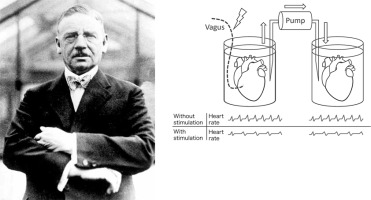
For his profound contributions to science, Otto Loewi was awarded the Nobel Prize in Physiology or Medicine in 1936, sharing the honor with Henry Hallett Dale. Their collaborative findings were instrumental in establishing the chemical communication between nerve cells and muscles as a central dogma of neurological communication. Loewi’s work, facilitated by the isolated heart model, remains a cornerstone in cardiac research, illustrating the model’s crucial role in advancing our understanding of complex physiological processes. This breakthrough has paved the way for subsequent discoveries and therapeutic innovations in both cardiology and neurology, underscoring the lasting impact of Loewi’s research on medical science [29, 30].
Otto Frank’s contributions to understanding cardiac mechanics
Otto Frank, a German physiologist (1865–1944), made substantial contributions to heart physiology through his innovative use of the isolated heart perfusion experimental model [31, 32]. His seminal work in the early 20th century focused on understanding the dynamic changes in pressure and volume within the heart during each cardiac cycle, leading to the formulation of what is now known as the Frank-Starling Law of the Heart in conjunction with Ernest Starling (Figure 7) [33].
Figure 7
Otto Frank with the first pressure-volume diagram he created, demonstrating the fundamental relationship between these two parameters in cardiac function
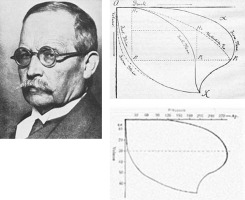
Frank’s experiments involved meticulously measuring the pressures and volumes in the isolated hearts of frogs and other animals under various conditions of load and filling [31]. By doing so, he was able to observe and document the intrinsic ability of cardiac muscle fibers to contract more forcefully when stretched – an observation critical to the development of the concept that the heart can intrinsically adjust its force of contraction to accommodate different volumes of blood [33].
One of his notable methodologies involved the use of the isolated heart perfusion model, which allowed for precise control over the experimental conditions [32]. This model enabled Frank to isolate the heart from external bodily influences and directly manipulate and measure the heart’s response to changes in preload and afterload. His rigorous approach provided a clearer understanding of the mechanical properties of the heart and how they influence cardiac function [31].
Frank’s research laid foundational knowledge for cardiac physiology, particularly in the understanding of the heart’s pumping mechanics. His work has been pivotal for further research in cardiac function and has had lasting impacts on clinical practices related to the management of heart diseases. Otto Frank’s legacy in cardiac research continues to influence contemporary understanding and treatment of cardiovascular conditions [32, 34].
Ernest Starling and the development of the Law of the Heart
Ernest Starling (1866–1927) embarked on his medical studies at just 16 years old at Guy’s Hospital, London, in 1882 [35]. His early academic journey led him to Wilhelm Kühne’s laboratory in Heidelberg, where he delved into the mechanisms of lymph formation, sparking his lifelong commitment to physiology. Between 1893 and 1897, Starling published a series of significant papers on lymph and capillary functions, demonstrating the dynamic balance of forces across the capillary wall, including hydrostatic pressure driving water outward and osmotic pressure from plasma proteins pulling it inward [36, 37].
Elected a fellow of the Royal Society in 1899, Starling’s career spanned various roles and significant contributions beyond academia. During World War I, he initially worked on poison gas research but later shifted to leverage his expertise as a chairman of the Royal Society’s Food Committee, devising nutritional strategies that notably improved the wartime diet in Britain [38].
Starling was first nominated for the Nobel Prize in 1913 by Otto Loewi, focusing on his work with hormones, particularly secretin. Although recommended for the prize, the disruptions of the First World War postponed the award. He was nominated again in 1926 for his renal studies, highlighting his pioneering hormone research, which, despite its impact, was considered too dated for Nobel recognition by then [39, 40].
The most enduring scientific legacy of Ernest Starling is the “Law of the Heart,” which he developed from 1910 to 1912 using anesthetized dogs in an isolated heart-lung model (Figure 8) [40, 41]. This research elucidated how the heart adjusts its contractility in response to increased blood volume, enhancing the size of its filling cavities. This discovery was crucial, though Starling was initially unaware of the related findings by Otto Frank, who had observed that cardiac muscle fibers contract more forcefully the more they are stretched, using the isolated frog heart. This parallel research by Frank and Starling culminated in what is now known as the Frank-Starling law, a fundamental principle that describes the intrinsic regulation of stroke volume through myocardial stretch and is a cornerstone of cardiovascular physiology [40, 42].
Howard E. Morgan & James R. Neely: advancements in the functional model of the isolated heart
The narrative of isolated heart perfusion reached a pivotal milestone in the mid-20th century through the transformative work of James R. Neely (1935–1988) and Howard E. Morgan (1927–2009) at the Vanderbilt University School of Medicine’s Department of Physiology in Nashville, United States. Morgan later moved to Pennsylvania State University in Hershey as the Chairman of the Department of Physiology, continuing his influential research on the isolated rat heart in collaboration with Neely [3].
Their significant modification of Langendorff’s classic heart model evolved into a dynamic “working heart” setup. This new model began with retrograde perfusion of fully isolated rat hearts via a cannula from a reservoir elevated 70 cm above the heart. This initial phase, lasting about 10 min, was critical for removing blood and allowing the heart to recover from anoxia incurred during resection and the start of perfusion. Following this, the left atrium was intubated and secured, setting the stage for active cardiac function (Figure 9). Cardiac work commenced with the initiation of flow from the atrial bubble trap into the left atrium [43].
Figure 9
Howard E. Morgan featured with the functional isolated heart system he co-developed with James R. Neely, showing the sophisticated equipment and its capabilities in modern cardiac research
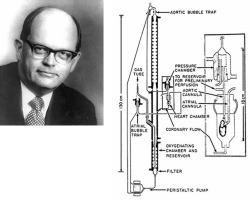
The perfusion system was ingeniously designed with a pressure chamber connected to the aortic cannula, partially filled with air to introduce some elasticity to the system. As ventricular contractions generated pressure, this setup propelled the fluid through a tube back into an aortic bubble trap positioned 70 cm above the heart. The fluid’s circuit through this system ensured more than adequate cardiac output for coronary perfusion, with the potential to increase cardiac workload by adjusting the left atrial filling pressure through the relative height of the atrial bubble trap [3, 43].
The perfusion solution used was a specially modified bicarbonate buffer, equilibrated with a 95% O2 and 5% CO2 gas mix, catering to the precise metabolic and functional needs of the heart under study. This model has been adapted by numerous laboratories worldwide, supporting various studies on cardiac metabolism and coronary regulation. Innovations such as the use of nuclear magnetic resonance techniques and the continuous measurement of left ventricular pressure with ultraminiature catheter-tip manometers have further refined this model, enhancing the understanding of cardiac function and the reliability of experimental outcomes [43].
Through their work, Morgan and Neely not only advanced the field of cardiac physiology but also established a foundational experimental model that continues to influence cardiovascular research globally. Their contributions have allowed for a deeper exploration into the heart’s intricate mechanisms, bridging past methodologies with contemporary scientific needs [3].
Current uses and future perspectives of isolated heart perfusion models
Isolated heart perfusion models, which have significantly evolved since their inception in the late 19th century, continue to play a pivotal role in cardiovascular research. These models enable researchers to study the heart in a controlled environment, isolated from the systemic influences of the whole organism, making them invaluable for detailed physiological and pharmacological investigations. This controlled setting helps in understanding cardiac functions and disease mechanisms with precision [1, 44, 45].
Although the experimental model developed by Langendorff and his predecessors has undergone many modifications and alterations, the basic principles and ideas remain relevant in contemporary research. Currently, isolated heart models are extensively used for pharmacological testing, allowing researchers to directly observe the effects of drugs on heart rate, rhythm, contractility, and metabolic pathways without the confounding variables present in whole-animal studies [46–48]. They are also crucial in disease modeling, simulating conditions such as ischemia-reperfusion injury, hypertrophy, and heart failure to understand underlying mechanisms and test therapeutic interventions. In academia, these models serve as an essential educational tool for physiology and pharmacology students, providing hands-on experience with cardiac dynamics [49].
Technological advancements have significantly enhanced the capabilities of isolated heart models [3]. High-resolution imaging techniques like MRI and PET are used to provide real-time, detailed images of cardiac function, while integration with bioengineering has led to the development of 3D-printed heart tissues and organs-on-chips that simulate more realistic cardiac physiology [50–52]. Additionally, advanced genomic and proteomic techniques allow for detailed analysis of changes within the heart under various conditions, aiding in the discovery of new therapeutic targets [53]. Moreover, the isolated perfusion model expands opportunities for targeted immunomodulation, building tolerance to ischemia-reperfusion injury, and correcting pathogenic genetic defects. The use of gene-editing therapies to address heart diseases caused by genetic mutations during ex situ heart perfusion appears promising [54].
Looking to the future, isolated heart perfusion models are expected to become even more integral to cardiovascular research. The potential developments include the use of these models for testing individualized treatment regimens in the field of precision medicine, combining them with stem cell technology to improve methods for testing stem cell therapies on regenerated or repaired heart tissues, and integrating automation and artificial intelligence to enhance research efficiency. Moreover, advances in bioengineering and synthetic biology might allow for the creation of fully synthetic or bioartificial hearts that can be used in research without the ethical concerns associated with animal use.
As these technologies develop and integrate with existing models, isolated heart perfusion methods will continue to be at the forefront of innovations in understanding heart physiology and developing treatments for cardiac diseases, bridging experimental research and clinical applications in exciting new ways.
Conclusions
The isolated heart perfusion model has been a cornerstone in the field of cardiovascular research, providing invaluable insights into the intricate workings of the heart. From its early development by pioneers like Langendorff and Starling to the sophisticated modifications by Morgan and Neely, this model has evolved significantly, adapting to the technological and scientific advancements of each era. Today, it continues to be a vital tool, not only for understanding cardiac physiology and pathology but also for testing pharmacological agents and exploring disease mechanisms. Looking forward, the integration of cutting-edge technologies such as genomics, bioengineering, and artificial intelligence promises to further enhance the capabilities of isolated heart models, paving the way for groundbreaking discoveries and innovations in cardiovascular medicine. As we continue to refine and expand the applications of this model, its role in translating basic science into clinical therapies is likely to become even more significant, offering hope for better diagnostic, therapeutic, and preventive measures against heart disease.



